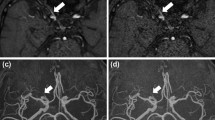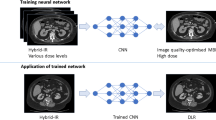Abstract
Purpose
The aim of this study is to assess the effect of super-resolution deep learning-based reconstruction (SR-DLR), which uses k-space properties, on image quality of intracranial time-of-flight (TOF) magnetic resonance angiography (MRA) at 3 T.
Methods
This retrospective study involved 35 patients who underwent intracranial TOF-MRA using a 3-T MRI system with SR-DLR based on k-space properties in October and November 2022. We reconstructed MRA with SR-DLR (matrix = 1008 × 1008) and MRA without SR-DLR (matrix = 336 × 336). We measured the signal-to-noise ratio (SNR), contrast, and contrast-to-noise ratio (CNR) in the basilar artery (BA) and the anterior cerebral artery (ACA) and the sharpness of the posterior cerebral artery (PCA) using the slope of the signal intensity profile curve at the half-peak points. Two radiologists evaluated image noise, artifacts, contrast, sharpness, and overall image quality of the two image types using a 4-point scale. We compared quantitative and qualitative scores between images with and without SR-DLR using the Wilcoxon signed-rank test.
Results
The SNRs, contrasts, and CNRs were all significantly higher in images with SR-DLR than those without SR-DLR (p < 0.001). The slope was significantly greater in images with SR-DLR than those without SR-DLR (p < 0.001). The qualitative scores in MRAs with SR-DLR were all significantly higher than MRAs without SR-DLR (p < 0.001).
Conclusion
SR-DLR with k-space properties can offer the benefits of increased spatial resolution without the associated drawbacks of longer scan times and reduced SNR and CNR in intracranial MRA.






Similar content being viewed by others
Data sharing statement
The datasets generated or analyzed during the study are available from the corresponding author on reasonable request.
Abbreviations
- ACA:
-
Anterior cerebral artery
- BA:
-
Basilar artery
- CNR:
-
Contrast-to-noise ratio
- DLR:
-
Deep learning-based reconstruction
- FWHM:
-
Full width at half maximum
- PCA:
-
Posterior cerebral artery
- SNR:
-
Signal-to-noise ratio
- SR-DLR:
-
Super-resolution deep learning reconstruction
References
Mandell DM, Mossa-Basha M, Qiao Y et al (2017) Intracranial vessel wall MRI: principles and expert consensus recommendations of the American Society of Neuroradiology. AJNR Am J Neuroradiol 38:218–229. https://doi.org/10.3174/ajnr.A4893
Park JE, Jung SC, Lee SH et al (2017) Comparison of 3D magnetic resonance imaging and digital subtraction angiography for intracranial artery stenosis. Eur Radiol 27:4737–4746. https://doi.org/10.1007/s00330-017-4860-6
Willinek WA, Born M, Simon B et al (2003) Time-of-flight MR angiography: comparison of 3.0-T imaging and 1.5-T imaging--initial experience. Radiology 229:913–920. https://doi.org/10.1148/radiol.2293020782
Meixner CR, Liebig P, Speier P et al (2019) High resolution time-of-flight MR-angiography at 7 T exploiting VERSE saturation, compressed sensing and segmentation. Magn Reson Imaging 63:193–204. https://doi.org/10.1016/j.mri.2019.08.014
Stalder AF, Schmidt M, Quick HH et al (2015) Highly undersampled contrast-enhanced MRA with iterative reconstruction: integration in a clinical setting. Magn Reson Med 74:1652–1660. https://doi.org/10.1002/mrm.25565
Kidoh M, Shinoda K, Kitajima M et al (2020) Deep learning based noise reduction for brain MR imaging: tests on phantoms and healthy volunteers. Magn Reson Med Sci 19:195–206. https://doi.org/10.2463/mrms.mp.2019-0018
Uetani H, Nakaura T, Kitajima M et al (2021) A preliminary study of deep learning-based reconstruction specialized for denoising in high-frequency domain: usefulness in high-resolution three-dimensional magnetic resonance cisternography of the cerebellopontine angle. Neuroradiology 63:63–71. https://doi.org/10.1007/s00234-020-02513-w
Uetani H, Nakaura T, Kitajima M et al (2022) Hybrid deep-learning-based denoising method for compressed sensing in pituitary MRI: comparison with the conventional wavelet-based denoising method. Eur Radiol 32:4527–4536. https://doi.org/10.1007/s00330-022-08552-6
Higaki T, Nakamura Y, Tatsugami F et al (2019) Improvement of image quality at CT and MRI using deep learning. Jpn J Radiol 37:73–80. https://doi.org/10.1007/s11604-018-0796-2
Yasaka K, Akai H, Sugawara H et al (2022) Impact of deep learning reconstruction on intracranial 1.5 T magnetic resonance angiography. Jpn J Radiol 40:476–483. https://doi.org/10.1007/s11604-021-01225-2
Akai H, Yasaka K, Sugawara H et al (2023) Commercially available deep-learning-reconstruction of MR imaging of the knee at 1.5T has higher image quality than conventionally-reconstructed imaging at 3T: a normal volunteer study. Magn Reson Med Sci 22:353–360. https://doi.org/10.2463/mrms.mp.2022-0020
Chaudhari AS, Fang Z, Kogan F et al (2018) Super-resolution musculoskeletal MRI using deep learning. Magn Reson Med 80:2139–2154. https://doi.org/10.1002/mrm.27178
Chaudhari AS, Stevens KJ, Wood JP et al (2020) Utility of deep learning super-resolution in the context of osteoarthritis MRI biomarkers. J Magn Reson Imaging 51:768–779. https://doi.org/10.1002/jmri.26872
Pham CH, Tor-Diez C, Meunier H et al (2019) Multiscale brain MRI super-resolution using deep 3D convolutional networks. Comput Med Imaging Graph 77:101647. https://doi.org/10.1016/j.compmedimag.2019.101647
Du YP, Parker DL, Davis WL, Cao G (1994) Reduction of partial-volume artifacts with zero-filled interpolation in three-dimensional MR angiography. J Magn Reson Imaging 4:733–741. https://doi.org/10.1002/jmri.1880040517
Bernstein MA, Fain SB, Riederer SJ (2001) Effect of windowing and zero-filled reconstruction of MRI data on spatial resolution and acquisition strategy. J Magn Reson Imaging 14:270–280. https://doi.org/10.1002/jmri.1183
Nakaura T, Higaki T, Awai K et al (2020) A primer for understanding radiology articles about machine learning and deep learning. Diagn Interv Imaging 101:765–770. https://doi.org/10.1016/j.diii.2020.10.001
Mazurowski MA, Buda M, Saha A, Bashir MR (2019) Deep learning in radiology: an overview of the concepts and a survey of the state of the art with focus on MRI. J Magn Reson Imaging 49:939–954. https://doi.org/10.1002/jmri.26534
Wicaksono KP, Fujimoto K, Fushimi Y et al (2022) Super-resolution application of generative adversarial network on brain time-of-flight MR angiography: image quality and diagnostic utility evaluation. Eur Radiol. https://doi.org/10.1007/s00330-022-09103-9
Zhang K, Haoji H, Philbrick K et al (2021) SOUP-GAN: super-resolution MRI using generative adversarial networks. Tomography. https://doi.org/10.3390/tomography8020073
Miyazawa H, Natori T, Kameda H et al (2019) Detecting lenticulostriate artery lesions in patients with acute ischemic stroke using high-resolution MRA at 7 T. Int J Stroke 14:290–297. https://doi.org/10.1177/1747493018806163
Radojewski P, Slotboom J, Joseph A et al (2021) Clinical implementation of 7T MRI for the identification of incidental intracranial aneurysms versus anatomic variants. Am J Neuroradiol. https://doi.org/10.3174/ajnr.a7331
Koktzoglou I, Huang R, Huang R et al (2021) Super-resolution head and neck MRA using deep machine learning. Magn Reson Med 86:335–345. https://doi.org/10.1002/mrm.28738
Sharma SD, Fong CL, Tzung BS et al (2013) Clinical image quality assessment of accelerated magnetic resonance neuroimaging using compressed sensing. Invest Radiol 48:638–645. https://doi.org/10.1097/RLI.0b013e31828a012d
Acknowledgment
We thank Ms. Tae Hamakawa from Department of Diagnostic Radiology, Kumamoto University, Japan, for her help with the measuring in the quantitative analysis. We thank Mr. Takumi Saito from Canon Medical systems for the adjustment of SR-DLR reconstruction parameters.
Funding
No funding.
Author information
Authors and Affiliations
Corresponding author
Ethics declarations
Conflict of interest statement
Toshinori Hirai has received research support from Canon Medical Systems. Yuichi Yamahita is an employee of Canon Medical Systems. Canon Medical Systems had no control over the interpretation, writing, or publication of this work.
Ethics approval
This retrospective study was approved by the institutional review board (Kumamoto University).
Informed consent
Informed consent for this retrospective study was waived by the institutional ethics committee.
Additional information
Publisher’s Note
Springer Nature remains neutral with regard to jurisdictional claims in published maps and institutional affiliations.
Rights and permissions
Springer Nature or its licensor (e.g. a society or other partner) holds exclusive rights to this article under a publishing agreement with the author(s) or other rightsholder(s); author self-archiving of the accepted manuscript version of this article is solely governed by the terms of such publishing agreement and applicable law.
About this article
Cite this article
Hokamura, M., Uetani, H., Nakaura, T. et al. Exploring the impact of super-resolution deep learning on MR angiography image quality. Neuroradiology 66, 217–226 (2024). https://doi.org/10.1007/s00234-023-03271-1
Received:
Accepted:
Published:
Issue Date:
DOI: https://doi.org/10.1007/s00234-023-03271-1




